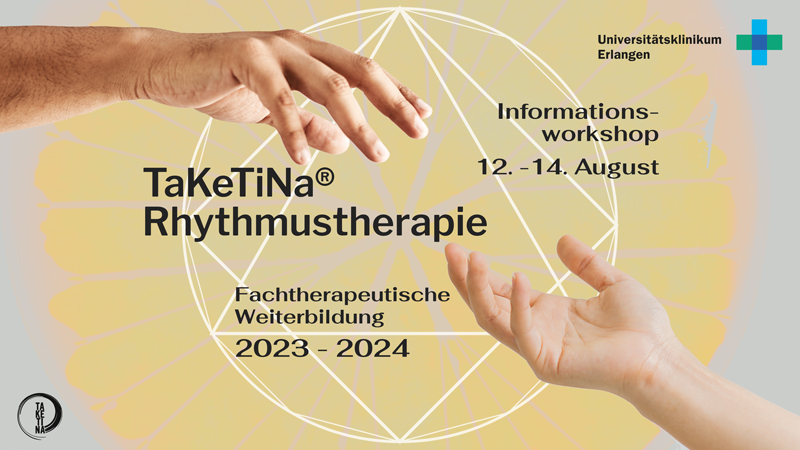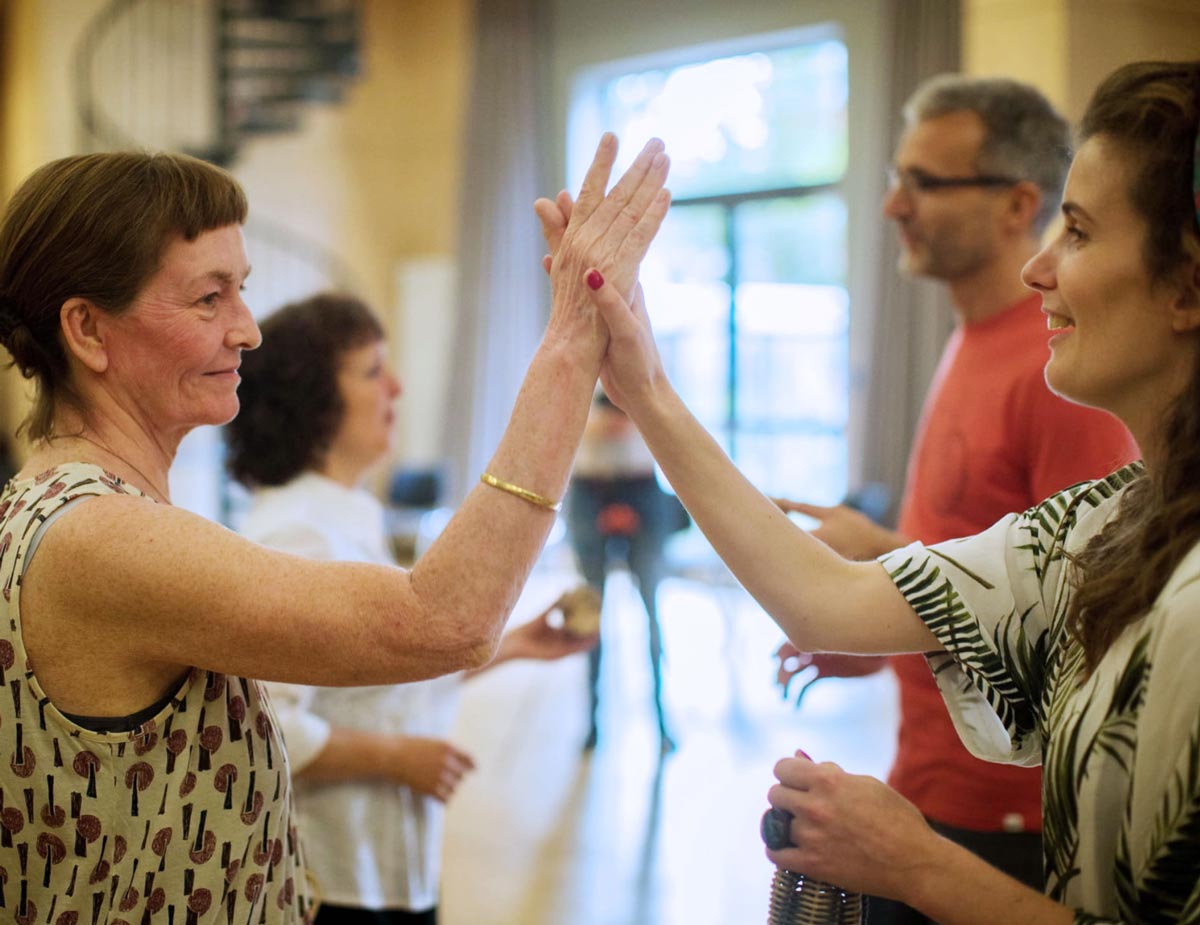TaKeTiNa® Rhythm Therapy
Specialized Therapeutic Continuing Education Program
2023 – 2024 in Nuremberg
This training program combines TaKeTiNa with therapy: Become a certified Rhythm Therapist and use the healing power of rhythm to lead people into deep processes of development and change.
Utilizing rhythm and music while working through individual difficulties creates fertile ground for personal development and successful therapeutic processes.
Music therapy has long existed in various forms to support healing, because making music promotes neuroplasticity on a physiological level and favors the development of sensory, motor and emotional abilities.
TaKeTiNa Rhythm Therapy is an interactive form of therapy that uses rhythm as a central element. Through its specific way of working, TaKeTiNa Rhythm Therapy can lead people deep into developmental processes and change.
Clients experience how they gain strength and joy of life by connecting to their musical roots. They are led into a network of sensing, listening, speaking, singing, moving and inner visualizing, which helps especially those who have lost contact with the body or certain bodily functions to consciously perceive and learn to feel.
The active, physical experience in the present moment in rhythm therapy is essential. While rhythm constantly maintains the connection to the “here and now”, difficult experiences from the past can be emotionally touched and integrated, especially when verbal communication is not possible.
Get to know the work of Rhythm Therapy
Because we want to make sure that the training is the right step for you, we want to give you these opportunities to get to know us and the work with TaKeTiNa® Rhythm Therapy. We will give you practical insights and personal guidance in different workshops.
Participation in one of the workshops is a prerequisite for registering for the advanced training.

◉ August 12 – 14 Information Workshop
with Frank Rihm, Reinhard Flatischler, Dr. Ali Behzad und Anna-Maria Flatischler in Nuremberg
Would you like to get to know rhythm therapy or do you have questions about this continuing education program? The information workshop is open to all who are interested in working with TaKeTiNa in the therapeutic field and want to learn more about it. In practical rhythm experiences you will realize the effect of rhythm on body, mind and soul. We will introduce you to therapeutic approaches and show you how rhythm can be an effective tool to accompany people on their journey.
We’ll inform you about:
- the extra-occupational concept of the professional therapeutic training
- TaKeTiNa – what it is, how it came about and why it is used in therapy
- the practical possibilities of rhythm therapy
- occupational fields of a rhythm therapist
- your professional perspectives
◉ September 2/3/4 Online Information Event
with Frank Rihm and Reinhard Flatischler via zoom
◉ Oktober 7 – 9 Selection workshop / introductory seminar
with Frank Rihm, Reinhard Flatischler and Anna-Maria Flatischler in Nuremberg
Information brochure
For more information, we will be happy to send you the brochure with information about the continuing education fees, dates, additional costs and organization.
Please enter your name and email address in the form below:
What are the contents of the continuing education?
-
Learning the TaKeTiNa process and being able to apply it in the therapeutic environment.
-
Be able to establish a therapeutic relationship with patients and conduct therapy conversations as well as rhythm conversations.
-
Gain rhythmic competence on instruments and practical knowledge about the healing effects of rhythm.
-
Experiential psychotherapy in rhythm: Present and experiential process facilitation, psychodynamic understanding, meaning and handling of transference and countertransference phenomena, structure-based work, handling conflicts and crises, etc.
Settings
Participants of the training learn to lead TaKeTiNa rhythm exercises. Using voice, steps and clapping movements, various rhythmic levels are built up, leading clients into whole-body experiences of rhythm.
TaKeTiNa’s therapeutic focus is primarily on leading small groups and individual work. It therefore works with simple polyrhythmic structures that are especially suited for setting inner processes in motion. A specially developed set of instruments makes it possible to respond flexibly to the needs of the clients.
The participants are introduced to the active shaping of a therapeutic relationship. They learn to verbally support the rhythm journeys, to intervene in a targeted way and to complete processes in such a way that patients can integrate the experiences made through TaKeTiNa. In addition, rhythm conversations are taught.
The rhythm therapist bases his offer on the individual situation of the client, as well as on the dynamics of the group. In the moment he decides how to combine psychotherapeutic and rhythmic processes in a meaningful way.
There are different settings to choose from:
- TaKeTiNa group setting (in large groups or small groups).
- TaKeTiNa in an individual setting
- Therapeutic conversations
- Rhythm conversations (rattle conversations or drum conversations)
For whom is the continuing education suitable?
This further education is intended for people who
- already have a profession that entitles and enables them to work with patients in a healing and therapeutic way.
- want to integrate the structuring and healing power of rhythm into their therapy work (outpatient as well as clinical).
Professional groups are e.g. physicians, psychologists, alternative practitioners, physiotherapists, sports and movement therapists, respiratory therapists, creative therapists, music therapists, art therapists, body (psycho)therapists, physical therapists, registered nurses, social workers/ social pedagogues (in therapeutic institutions) or speech therapists.
Teachers
This training is led by Frank Rihm (Head Creative Therapist at Fachklinik Heiligenfeld), Reinhard Flatischler (founder of TaKeTiNa) and Bettina Berger (HAKOMI Teaching Therapist and M.D. in Psychosomatic Medicine and Psychotherapy). The lecturers have extensive practical experience in integrating rhythm into psychotherapy and will show participants how rhythm can be used in developmental processes. They will be supported by Dr. Ali Behzad (University Hospital Erlangen) and Anna-Maria Flatischler (TaKeTiNa and music educator).
TaKeTiNa is now successfully used as an accompanying measure in various therapy areas in clinics and practices. The work done in the Heiligenfeld Clinics with TaKeTiNa rhythm therapy for more than two decades is one of the longest running projects.
The psychotherapeutic results are so convincing that the second continuing education course in rhythm therapy is now beginning. This is intended to enable participants to use rhythm competently and effectively in a therapeutic context.
What are the contents of the continuing education?
-
Learning the TaKeTiNa process and being able to apply it in the therapeutic environment.
-
Be able to establish a therapeutic relationship with patients and conduct therapy conversations as well as rhythm conversations.
-
Gain rhythmic competence on instruments and practical knowledge about the healing effects of rhythm.
-
Experiential psychotherapy in rhythm: Present and experiential process facilitation, psychodynamic understanding, meaning and handling of transference and countertransference phenomena, structure-based work, handling conflicts and crises, etc.
Settings
Participants of the training learn to lead TaKeTiNa rhythm exercises. Using voice, steps and clapping movements, various rhythmic levels are built up, leading clients into whole-body experiences of rhythm.
TaKeTiNa’s therapeutic focus is primarily on leading small groups and individual work. It therefore works with simple polyrhythmic structures that are especially suited for setting inner processes in motion. A specially developed set of instruments makes it possible to respond flexibly to the needs of the clients.
The participants are introduced to the active shaping of a therapeutic relationship. They learn to verbally support the rhythm journeys, to intervene in a targeted way and to complete processes in such a way that patients can integrate the experiences made through TaKeTiNa. In addition, rhythm conversations are taught.
The rhythm therapist bases his offer on the individual situation of the client, as well as on the dynamics of the group. In the moment he decides how to combine psychotherapeutic and rhythmic processes in a meaningful way.
There are different settings to choose from:
- TaKeTiNa group setting (in large groups or small groups).
- TaKeTiNa in an individual setting
- Therapeutic conversations
- Rhythm conversations (rattle conversations or drum conversations)
For whom is the continuing education suitable?
This further education is intended for people who
- already have a profession that entitles and enables them to work with patients in a healing and therapeutic way.
- want to integrate the structuring and healing power of rhythm into their therapy work (outpatient as well as clinical).
Professional groups are e.g. physicians, psychologists, alternative practitioners, physiotherapists, sports and movement therapists, respiratory therapists, creative therapists, music therapists, art therapists, body (psycho)therapists, physical therapists, registered nurses, social workers/ social pedagogues (in therapeutic institutions) or speech therapists.
Teachers
This training is led by Frank Rihm (Head Creative Therapist at Fachklinik Heiligenfeld), Reinhard Flatischler (founder of TaKeTiNa) and Bettina Berger (HAKOMI Teaching Therapist and M.D. in Psychosomatic Medicine and Psychotherapy). The lecturers have extensive practical experience in integrating rhythm into psychotherapy and will show participants how rhythm can be used in developmental processes. They will be supported by Dr. Ali Behzad (University Hospital Erlangen) and Anna-Maria Flatischler (TaKeTiNa and music educator).
TaKeTiNa is now successfully used as an accompanying measure in various therapy areas in clinics and practices. The work done in the Heiligenfeld Clinics with TaKeTiNa rhythm therapy for more than two decades is one of the longest running projects.
The psychotherapeutic results are so convincing that the second continuing education course in rhythm therapy is now beginning. This is intended to enable participants to use rhythm competently and effectively in a therapeutic context.






